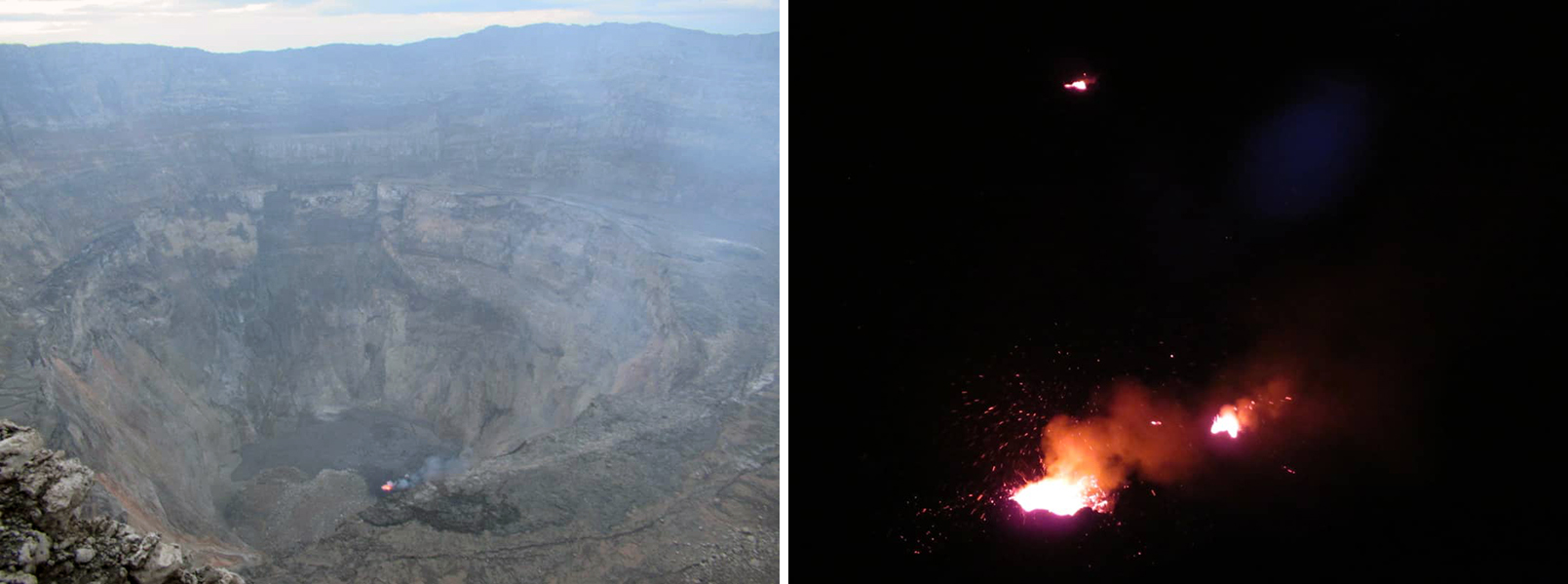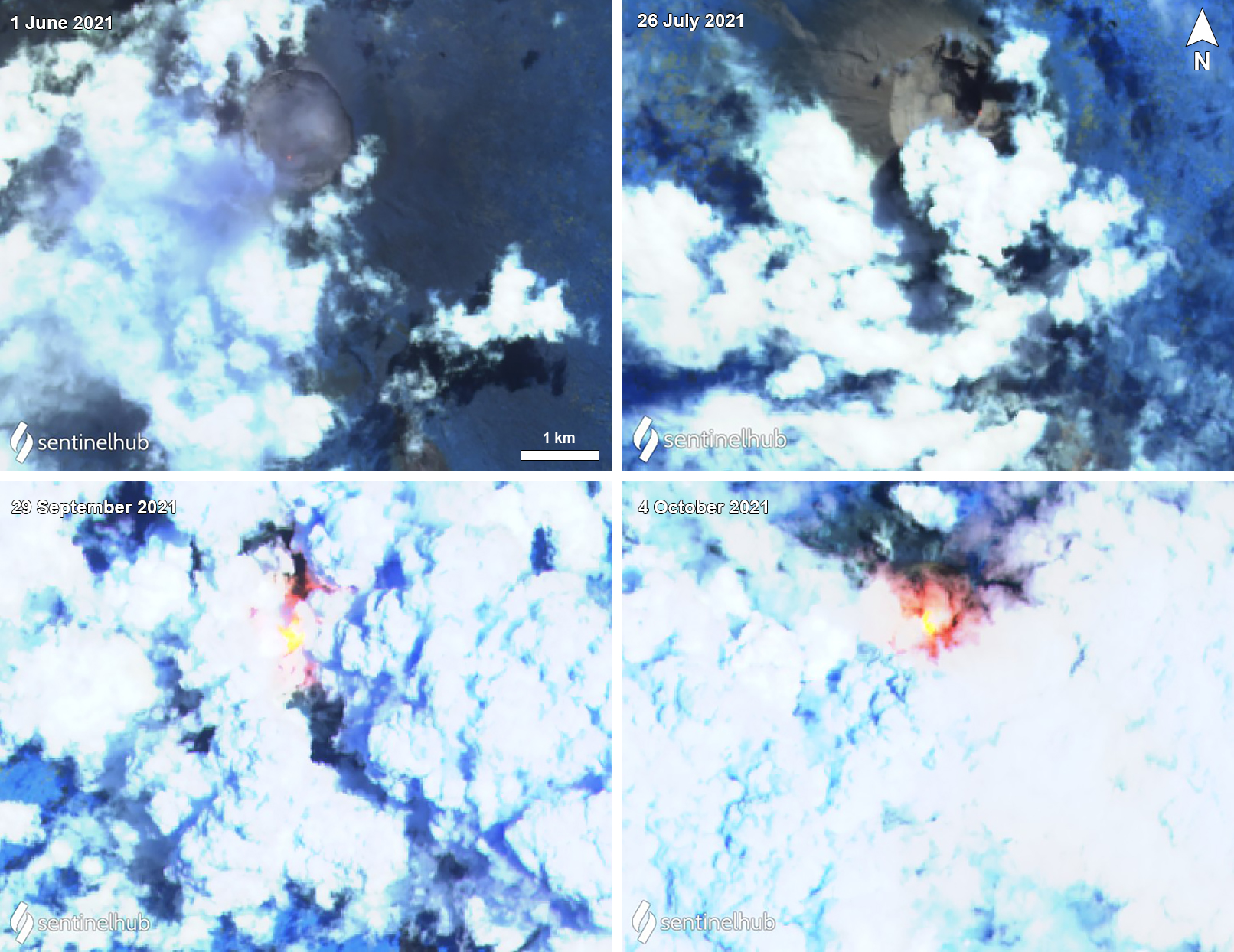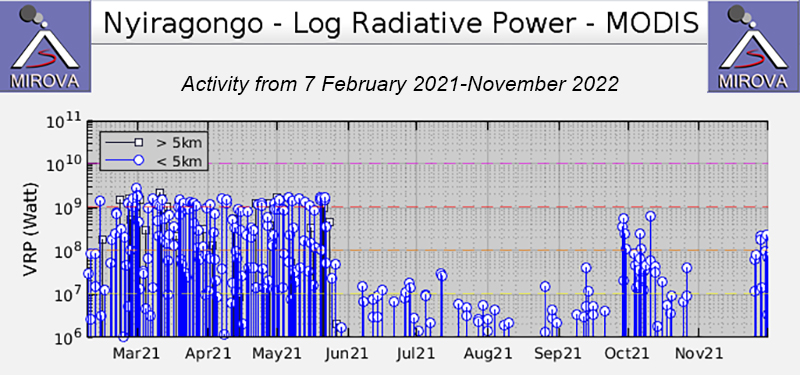Report on Nyiragongo (DR Congo) — December 2021
Bulletin of the Global Volcanism Network, vol. 46, no. 12 (December 2021)
Managing Editor: Benjamin Andrews.
Edited by Kadie L. Bennis.
Nyiragongo (DR Congo) Active lava on the crater floor creates thermal anomalies and spatter after mid-September 2021
Please cite this report as:
Global Volcanism Program, 2021. Report on Nyiragongo (DR Congo) (Bennis, K.L., and Andrews, B., eds.). Bulletin of the Global Volcanism Network, 46:12. Smithsonian Institution. https://doi.org/10.5479/si.GVP.BGVN202112-223030
Nyiragongo
DR Congo
1.52°S, 29.25°E; summit elev. 3470 m
All times are local (unless otherwise noted)
Nyiragongo, in the Democratic Republic of the Congo, is part of the Virunga Volcanic Province (VVP) along the western branch of the East African Rift System. It contains a 1.2 km-wide summit crater with a lava lake that has been active since at least 1971. Lava flows have been a hazard in the past for the nearby city of Goma (15 km S); with recent documented lava flows occurring in April 2019 from a secondary cone that had formed in February 2016, accompanied by ejecta (BGVN 44:05). These flows, along with those that were reported during February and March 2016 (BGVN 42:01), were confined to the crater lake. Volcanism has typically consisted of lava lake activity (evidenced by strong thermal anomalies), incandescence, and gas-and-steam emissions (BGVN 45:12). During May 2021, however, a notable flank fissure eruption consisted of intense seismicity, lava lake drainage, lava flows reaching Goma, and ash plumes (BGVN 46:06). This report covers activity during June through November 2021 and describes lower-power thermal anomalies. The volcano is monitored by the Observatoire Volcanologique de Goma (OVG) and various satellite instruments.
A small area of incandescence was observed from the crater floor on 1 June and 26 July in Sentinel-2 infrared satellite imagery (figure 89). OVG reported that on 4 August a gas-and-ash plume was visible at 1420. On 18 September OVG reported that lava had returned to the summit crater, according to a Sentinel satellite image. Notable thermal anomalies were also visible on 29 September and 4 October in infrared satellite imagery, despite cloud cover (figure 89). On 27 November the active vents on the crater floor were observed ejecting spatter (figure 90).
 |
Figure 90. Photos of the main crater floor of Nyiragongo showing ongoing incandescence, spatter, and minor gas-and-steam emissions on 27 November 2021. Courtesy of Charles Balagizi, OVG. |
MIROVA (Middle InfraRed Observation of Volcanic Activity) analysis of MODIS satellite data showed a significant decrease in the power of the thermal anomalies after the notable eruption in May 2021. Though anomalies continued to be detected in the summit crater, they were also less frequently detected compared to the previous months (figure 91). A pulse in activity was observed during late September through mid-October, which was also reflected in Sentinel-2 infrared satellite images, despite the cloud cover (figure 89), and in the MODVOLC data. According to the MODVOLC thermal algorithm, a total of 24 thermal alerts were issued during the reporting period: one on 27 June, one on 12 September, 7 on 28 September, 6 on 29 September, one on 3 October, two on 6 October, two on 12 October, two on 27 November, and two on 29 November.
Geological Summary. The Nyiragongo stratovolcano contained a lava lake in its deep summit crater that was active for half a century before draining catastrophically through its outer flanks in 1977. The steep slopes contrast to the low profile of its neighboring shield volcano, Nyamuragira. Benches in the steep-walled, 1.2-km-wide summit crater mark levels of former lava lakes, which have been observed since the late-19th century. Two older stratovolcanoes, Baruta and Shaheru, are partially overlapped by Nyiragongo on the north and south. About 100 cones are located primarily along radial fissures south of Shaheru, east of the summit, and along a NE-SW zone extending as far as Lake Kivu. Many cones are buried by voluminous lava flows that extend long distances down the flanks, which is characterized by the eruption of foiditic rocks. The extremely fluid 1977 lava flows caused many fatalities, as did lava flows that inundated portions of the major city of Goma in January 2002.
Information Contacts: Observatoire Volcanologique de Goma (OVG), Departement de Geophysique, Centre de Recherche en Sciences Naturelles, Lwiro, D.S. Bukavu, DR Congo; MIROVA (Middle InfraRed Observation of Volcanic Activity), a collaborative project between the Universities of Turin and Florence (Italy) supported by the Centre for Volcanic Risk of the Italian Civil Protection Department (URL: http://www.mirovaweb.it/); Hawai'i Institute of Geophysics and Planetology (HIGP) - MODVOLC Thermal Alerts System, School of Ocean and Earth Science and Technology (SOEST), Univ. of Hawai'i, 2525 Correa Road, Honolulu, HI 96822, USA (URL: http://modis.higp.hawaii.edu/); Sentinel Hub Playground (URL: https://www.sentinel-hub.com/explore/sentinel-playground); Charles Balagizi, Observatoire Volcanologique de Goma (OVG), Departement de Geophysique, Centre de Recherche en Sciences Naturelles, Lwiro, D.S. Bukavu, DR Congo; (Twitter: @CharlesBalagizi, https://twitter.com/CharlesBalagizi).



